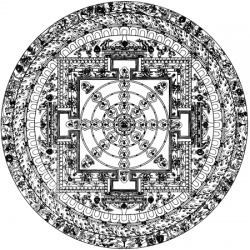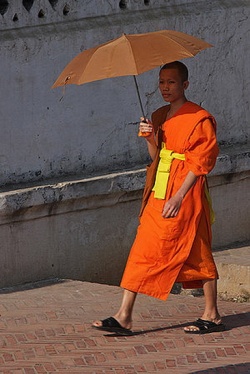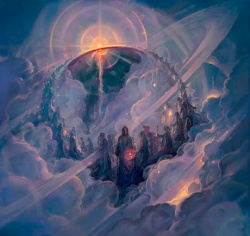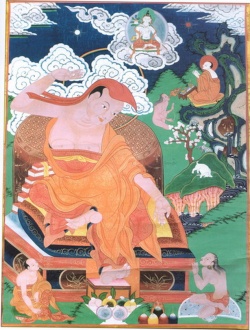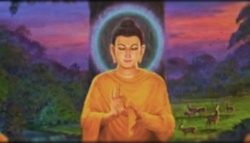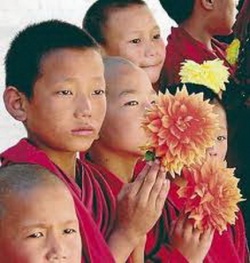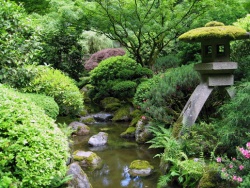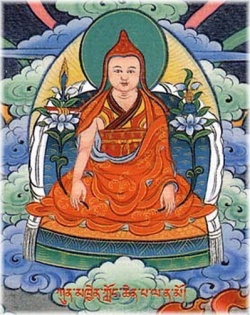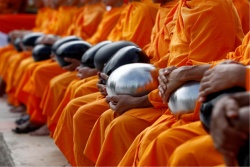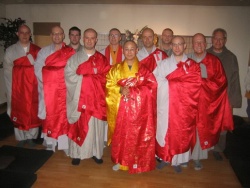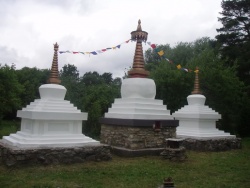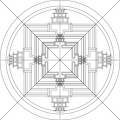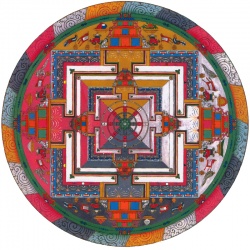Maṇḍala of 100 types of yoginī
Depictions of the maṇḍala of the 100 types of yoginī (rigs brgya'i rnal 'byor ma) are quite rare. The maṇḍala is used as the basis for offerings to the hundred types of yoginī; this is an optional part of the offering ritual (dpal dus kyi 'khor lo'i mchod chog nyer mkho) by Tāranātha that is usually associated with the nine-deity maṇḍala practice, although it can be combined with any sādhana. Other writers whose similar works have been have been referred to for this article are Bodongpa Chokle Namgyal, "dus kyi 'khor lo'i tshogs kyi 'khor lo", and Mipham, with a more simple yoginī offering ritual as part of his main offering ritual for Kālacakra: "dus kyi 'khor lo'i dkyil 'khor mchod pa'i cho ga bsod nams gter mdzod".
The practice by Tāranātha combines the principles of two original Indian texts: one is an offering to the 64 yoginīs of the speech maṇḍala (brgyad brgyad drug cu rtsa bzhi'i rnal 'byor ma rnams kyi gtor ma'i cho ga) by Kīrticandra, and the other is the gaṇacakra for Kālacakra, involving 36 yoginīs (dpal dus kyi 'khor lo'i tshogs 'khor gyi cho ga, Kālacakrapāda). These 36 are associated with the same group of 36 goddesses from which the icchās and pratīcchās of the speech and body palaces in the general Kālacakra maṇḍala emanate.
The maṇḍala of the 100 yoginīs is a two-story palace, and describing it from the 2D point of view, it is similar to the mind and speech palaces of the normal Kālacakra maṇḍala. The outer palace is effectively identical to the normal speech palace and the inner palace is equivalent to the normal mind palace, but with a different internal structure. They are simply referred to as the outer and inner palaces. Anybody familiar with the main Cakrasamvara maṇḍalas will immediately recognize the structure of the inner palace. They are identical and they are clearly related. One of the main source texts for the offering to the 36 yoginīs is in fact the Cakrasamvara commentary, the Lakṣābhidhanād uddhṛita laghutantra piṇḍārthavivaraṇa (mngon par brjod pa 'bum pa las phyung ba nyung ngu'i rgyud kyi bsdus pa'i don rnam par bshad pa). This is by the bodhisattva Vajrapāṇi, and is one of the so-called bodhisattva trilogy of commentaries (sems 'grel skor gsum), all written from the perspective of Kālacakra.
The commentary lists the 36 goddesses and identifies each with one of a group that it calls the 36 messengers of caste (kuladūtikā, rigs kyi pho nya mo). The list is not exactly the same as that of the 36 yoginīs in the inner [[100 yoginī palace], but it is very close. Where there are differences, the yoginīs are almost certainly equivalents. The following list is based on the Cakrasamvara commentary, and includes the Sanskrit names of the yoginīs from that commentary. Comparing this list with that given in the Vimalaprabhā; there are some differences, and the Vimalaprabhā list is given later. The locations in this first list are their positions in the Cakrasamvara maṇḍala. Not all have equivalent Tibetan names; some with the same translations in Tibetan have different original Sanskrit names. The yoginī's names are indicative of a caste, profession or activity, and that is given last for each entry. For example, the first one given, Ḍākinī is in the Cakrasamvara maṇḍala and is identified with the yoginī Śūdrī, the lowest caste. Of the 36, only one, Vaṃśakārī, does not have a clear equivalent in the Vimalaprabhā lists. Her name suggests flute playing, and the one without a match in the Vimalaprabhā list is Śālinī – her name suggests weaving.
Central lotus:
<poem>
C: Akulīnā (rigs med pa) – Ḍombinī (g.yung mo) outcaste
E: Ḍākinī (mkha' 'gro ma) – Śūdrī (dmangs rigs ma) lowest caste
N: Lāmā – Kṣatriṇī (rgyal rigs ma) ruling or warrior caste
W: Khaṇḍarohā – Vaiśyā (rje'u rigs ma) merchant class
S: Rūpiṇī (gzugs can ma) – Brāhmaṇī (bram ze mo) Brahmin caste
On the spokes of the mind wheel:
E: Pracaṇḍā (rab gtum mo) – Aṃśukāriṇī ('od zer mkhan ma) bamboo dance
N: Caṇḍākṣī (gtum pa'i mig can ma) – Kalyapālinī (chang mkhan ma) selling or distilling alcoholic spirits
W: Prabhāvatī ('od ldan ma) – Mālākārī (phreng ba mkhan ma) garland making
S: Mahānāsā (sna chen ma) – Hemakārī (gser mgar mkhan ma) gold dealer
SE: Vīramatī (brtan pa'i blo can ma) – Kūpakartī (khron pa mkhan ma) well expertise
SW: Kharvarī (mi'u thung ma) – Veṇunartakī (smyig ma mkhan ma) working with bamboo/cane
NW: Laṅkeśvarī (lang ka'i dbang phyug ma) – Kaṃsakārī ('khar ba mkhan ma) bell making
NE: Drumacchāyā (shing grib ma) – Maṇikārī (nor bu mkhan ma) jewellery expertise
On the spokes of the speech wheel:
E: Airāvatī – Lohakārī (lcags mkhan ma) blacksmith
N: Mahābhairavā ('jigs byed chen mo) – Lākṣākārī (rgya skyegs mkhan ma) working with lac
W: Vāyuvegā (rlung gi shugs can ma) – Kośakārī (srin bal mkhan ma) working with silk
S: Surābhakṣī (chang 'thung ma) – Tailinī (til mar mkhan ma) (sesame) oil-milling
SE: Śyāmādevī – Nāpitī ('breg mkhan ma) barber
SW: Subhadrā (shin tu bzang mo) – Carmakārī (ko lpags mkhan ma) leather work
NW: Hayakarṇī (rta rna ma) – Kāṣṭhakārī (shing mkhan ma) carpentry
NE: Khagānanā – Vaṃśakārī (gling bu mkhan ma) flute playing
On the spokes of the body wheel:
E: Cakravegā ('khor lo'i shugs can ma) – Khaṭikinī (sha 'tshong ma) butchery
N: Khaṇḍarohā (dum skyes ma) – Kandukī (g.yos mkhan ma) cooking
W: Śauṇḍinī – Śībikā (tshem bu ma) tailoring
S: Cakravarmiṇī (khor lo'i go cha ma) – Naṭī (gar mkhan ma) dancing
SE: Suvīrā (shin tu dpa' mo) – Rajakī (tshos mkhan ma) clothes washing
SW: Mahābalā (stobs chen ma) – Kaivartī (nya pa ma) fishing
NW: Cakravartinī ('khor los bsgyur ma) – Kumbhakārī (rdza mkhan ma) pottery
NE: Mahāvīryā (brtson 'grus chen mo) – Gaṇikā (smad 'tshong ma) prostitution
In the doorways and corners of the palace (these are all outcaste or tribal groups):
E: Kākāsyā (khwa gdong ma) – Mlecchī (kla klo ma) barbarian, foreigner
N: Ulūkāsyā ('ug gdong ma) – Haḍḍinī ('phyag pa ma) sweeping, cleaning
W: Śvānāsyā (khyi gdong ma) – Mātaṅgī (gtum mo) caṇḍāla, an untouchable caste
S: Śūkarāsyā (phag gdong ma) – Tāpinī (stag gzig ma) Persian, Turkic
SE: Yamadāhī (gshin rje brtan ma) – Śavarī (ri khrod ma) leaf-clad, a mountain-tribe
SW: Yamadūtī (gshin rje pho nya ma) – Bhillī, an aboriginal group
NW: Yamadaṃṣṭriṇī (gshin rje mche ba ma) – Pukkasī (ro sreg ma) cremation
NE: Yamamathanī (gshin rje 'joms ma) – Barbarī (smyon thabs ma) stammering, lunacy
Drawing the maṇḍala
The drawing of the 100 yoginī maṇḍala is described by Banda Gelek in his text, "The Illuminating Sun-rays" (rje sgrol ba'i mgon pos mdzad pa'i dkyil chog rgya mtsho'i thig tshon gsal byed nyi ma'i 'od zer). For units, he refers mostly to 1/6 DU of the inner palace, using these in much the same way a minor units in the general maṇḍala. It is simplest if I call these minor units throughout, understanding that DUs in the inner palace are half the size of those in the outer palace. So:
1 outer-DU equals 2 inner-DU equals 12 mus.
7 The completed maṇḍala
Pic 1Banda Gelek's description is very brief, and he does not even mention the need to first draw the eight main lines – this is simply understood. For a description of how to draw these, see the three diagrams and the associated text here. His description starts by dividing the distance (along a central line) from the centre of the space on which the maṇḍala is drawn to the ouside edge into 10 equal parts. This gives the radius of the outer perimeter circle as 10 outer-DUs or 120 mus. Halfway through the ninth of these divisions draw a circle. This will have a radius of 102 mus. Draw a square with vertices where this circle intersects the diagonal lines. This is the parapet line for the outer palace.
Pic 2The distance from the sides of this square to the central lines will be approximately 72 mus (if accurately drawn, 72.12 mus). The distance between this outer parapet line and the centre is now divided into three, and two further squares drawn – these squares will have sides 24 and 48 mus from the central lines. These are the base lines for the inner and outer palaces.
Pic 3Exactly mid-way between these two base lines (36 mus from the central lines) draw another square for the parapet line of the inner palace. Measure in from the outer base line, 1 and then 4 mus, the draw squares for the small gap and the podium in the outer palace. These dimensions are exactly the same as with the speech palace of the main Kālacakra maṇḍala.
This maṇḍala has only two perimeters, a vajra-fence and garland of fire. The inner bounding circle of the vajra-fence has already been drawn, with a radius of 10 1/2 outer-DUs. Measure out from this 1/2 outer-DU and a whole DU and draw two further circles (with radii of 108 and 120 mus) to define these perimeters.
Pic 4The structure of the walls and the torans of both outer and inner palaces are exactly the same as with the general Kālacakra maṇḍala. It is safe to assume that this also includes the triple walls of the inner palace and the five-fold walls of the outer palace, with the small gaps between them.
Pic 5The inside of the inner palace is very different from the general maṇḍala and consists of three concentric wheels, each with eight spokes and a rim, and a central eight-petalled lotus, also with a rim.
First, measure along a central line 1 mu inside the base line of the inner palace, and draw a circle; this has a radius of 23 mus. The radius of this now has to be divided into four, and further three circles drawn; these will have radii of 5.75, 11.5 and 17.25 mus. These represent the outer edge of the hub on which the central lotus sits and the outer edges of the three rims. Next, measure 1 mu inside each of these circles and draw three further circles; these form the inside edges of the rim surrounding the central lotus and the three other rims. The innermost of these circles, with a radius of 4.75 mus, is treated as the extent of the central lotus, which is then drawn as with the Kālacakra maṇḍala, with a receptacle one third the diameter of the whole.
The central lotus and its rim are the Circle of Great Bliss, then next wheel is the mind wheel and its rim, then the speech wheel and body wheel, each with its rim.
Pic 6Spokes for these wheels need to be drawn, and Banda Gelek states that these are done similarly to the Cakrasamvara maṇḍala in the tradition of Kṛiṣṇapāda. The dimensions of the Cakrasamvara maṇḍala are not the same, but adjusting for the present maṇḍala, the following will produce good results.
The key is to find points for the thickness of the spokes, at their bases, middle and ends. So far, each wheel consists of three circles. Taking the speech wheel as an example, these are: its inner bounding circle, which is also the outer boundary of the mind wheel rim; the inner boundary of the speech rim; and, the outer boundary of the speech rim, which is also the inner bounding circle of the body wheel.
For each wheel, draw a construction circle that lies approximately halfway between the inner bounding circle and the outer boundary of its rim. Then, where the central and diagonal lines intersect these three circles, draw arcs either side to intersect thos circles. Use a radius of 1.2 mus on the innermost circle, 2.1 mus in the middle and 1.75 on the outer edge. Then draw the spokes connecting these points. The dimensions do not need to be exactly the same as these, and artistic licence is clearly allowed.
Pic 7,Completed mandalaThis completes the maṇḍala construction, and Banda Gelek now moves on the describe the colours for the maṇḍala. The colours are similar to those for the mind and speech palaces of the main Kālacakra maṇḍala, except for the following. The body wheel is white, the speech wheel red and the mind wheel black. By wheel is meant both the spokes and the rim of each wheel. The spaces between these are the colours of the directions, being the floor underneath the wheels.
The central lotus is green and the ground surrounding it is blue; there is not much of this, just the spaces between the outer curves of the lotus petals and the green rim of the circle of great bliss.
The four rims are decorated with, from the inside, green curved knives, black swords, red lotuses and white crossed vajras, using either eight or 16 on each rim as appropriate – these are in practice rather small details.
In the outer palace, the podium has eight lotuses, all of which are identical to those in the speech palace of the main maṇḍala.
The two perimeters, the vajra-fence and garland of fire are coloured as with the main maṇḍala. The vajra-fence has green vajras on a blue background, and the garland of fire consists of either five or six colours.
The description now moves on to the emblems for the deities. It seems that it is expected the deities would be represented by bindu, although emblems and full forms would be quite correct. Which full form? In the meditation practice, the group of 36 take one form first, and then change into another set of goddesses altogether. The emblems or bindu certainly seem the most likely to use.
The outer palace is easiest to describe first. The goddesses that are on the lotuses are exactly the same as those in the speech palace of the main maṇḍala, including the central goddess on each lotus and her consort. These total 80 deities, so what does this do to the total number of deities in this maṇḍala? This is a maṇḍala of yoginīs, and so the male deities are not counted. Also, the eight central goddesses also appear on the speech wheel of the inner palace, and are not counted twice; the total is still 100 types of yoginī.
Now for the inner palace. The group of 36 – actually, 37 with the central goddess – start off in the meditation practice as the group of yoginīs or messengers mentioned earlier. They then transform, each via an emblem, into the group from which the icchās in the main maṇḍala are considered to be emanations: four buddha consorts, six bodhisattva consorts, four mind palace wrathful consorts, the eight chief goddesses of the speech palace, the six wrathfuls consorts on chariots, and, the eight pracaṇḍā. The two lists, together with their positions, colours and emblems, are given below. The emblems are usually a tool of the particular trade, such as the curved knife that would be used by a butcher, or in some instances the product of that trade, such as the bamboo parasol that would be produced by a bamboo worker.
On the central lotus:
C: green – Ḍombī (g.yung mo) outcaste – vajra – Vajradhātvīśvarī
E: black – Śūdrī (dmangs rigs ma) lowest caste – sword – Tārā
S: red – Kṣatriṇī (rgyal rigs ma) ruling caste – jewel – Pāṇḍarā
W: yellow – Vaiśyā (rje rigs ma) merchant caste – lotus – Locanā
N: white – Brāhmaṇī (bram ze mo) Brahmin caste – wheel – Māmakī
On the petals in the intermediate directions are skulls; these are all white like the Moon and full of nectar.
On the spokes of the mind wheel:
E: blue – Kāṃsyakārī ('khar ba mkhan ma) bell-making – vīṇā – Śabdavajrā
SE: black – Tantravāyī (thags mkhan ma) weaving – cloth – Sparśavajrā
S: blue – Veṇunartakī ('od ma'i gar mkhan ma) bamboo dance – vajra – Atinīlā
SW: red – Śauṇḍinī (chang 'tshong ma) selling alcohol – beer cup – Rasavajrā
W: green – Kūpakartrī (khron pa mkhan ma) well expertise – hoe – Raudrākṣī
NW: yellow – Mālākārī (phreng ba mkhan ma) garland making – wheel – Gandhavajrā – wheel
N: green – Maṇikārī (nor bu mkhan ma) jewellery – dharmodaya – Dharmadhātuvajrā
NE: white – Suvarṇakārī (gser mkhan ma) gold dealing – mirror – Rūpavajrā
For the wheel in the NW, a garland of flowers is given as an alternative.
On the spokes of the speech wheel:
E: black – Khaṭṭikī (sha 'tshong ma) butchery – curved knife – Cāmuṇḍā
SE: black – Kumbhakārī (rdza mkhan ma) pottery – pot – Vaiṣṇavyā
S: red – Kandukī ('khur ba mkhan ma) cookery – ladle – Vārāhī
SW: red – Veśyā (smad 'tshong ma) prostitution – yellow cloth – Kaumārī
W: yellow – Sīvikā (tshem bu ma) tailoring – needle – Sīvikā
NW: yellow – Kaivartī (nya pa ma) fishing – fish – Brahmāṇī
N: white – Naṭī (gar mkhan ma) dancing – trident – Raudrī
NE: white – Rajakīti (btso blag mkhan ma) washing – flat stone – Lakṣmī
On the spokes of the body wheel:
E: black – Lohakārī (lcags mkhan ma) blacksmithery – small knife – Ativīryā
SE: black – Veṇukārī (smyug ma mkhan ma) bamboo work – bamboo parasol – Śṛiṅkhalā
S: red – Lākṣākārī (rgya skyegs mkhan ma) working with lac – cooking pot – Jambhakī
SW: red – Kāṣṭakārī (shing mkhan ma) carpentry – clog(s) – Bhṛikuṭī
W: yellow – Kośakārī (srin bal mkhan ma) silk work – silk-worm – Stambhakī
NW: yellow – Carmaṃkārī (ko lpags mkhan ma) working with leather – sandal – Mārīcī
N: white – Tailinī (til mar mkhan ma) (sesame) oil-milling – kusha grass – Mānakī
NE: white – Nāpitī ('dregs mkhan ma) barbering – razor – Cundā
The small knife in the east is a small curved knife (chu gri, kṛipāṇī). The sandal in the north-west is a sandal that just covers the soles of the feet (mthil lham).
Then, the area beyond the wheels, but still inside the palace, is sometimes called the charnel grounds, although these are not represented, or the wheel of space. There are deities in each doorway (in the cardinal directions) and in each corner (the intermediate directions):
E: black – Mlecchā (kla klo ma) barbarian, foreigner – bull's horn – Śvārāsyā
SE: black – Varvarī ((b)snyon thabs ma) stammering, lunacy – stake/torch – Kākāsyā
S: red – Haḍḍinī ('phyag pa mo) sweeping, cleaning – earthenware bowl – Śūkarāsyā
SW: red – Pukkasī (ro sreg ma) burning of corpses – sitar (rgyud mangs) – Gṛidhrāsyā
W: yellow – Mātaṅgī (gtum mo) caṇḍāla, an untouchable caste– vīṇā (rgyud ldan) – Jambukāsyā
NW: yellow – Bhillī an aboriginal group – juniper – Garuḍāsyā
N: white – Tāpinī (stag gzig ma) Persian, Turkic – spindle – Vyāghrāsyā
NE: white – Śabarī (ri khrod ma) leaf-clad, a mountain-tribe – peacock feather – Ulūkāsyā
The outer palace contains a single plinth with eight lotuses. The deities on these are exactly the same as those in the speech palace of the main Kālacakra maṇḍala. There is no group of 36 goddesses on the outer plinth of the palace; no icchās ('dod ma) nor pratīcchās (phyir 'dod ma/mi 'dod ma).
This completes Banda Gelek's description of the maṇḍala of the 100 types of yoginī.
E. Henning
